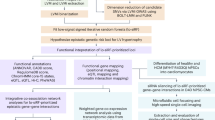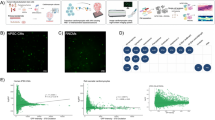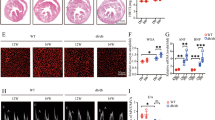Abstract
The RasGAP SH3 domain-binding proteins (G3BPs) are a family of RNA-binding proteins that can co-ordinate signal transduction and post-transcriptional gene regulation. G3BPs have been shown to be involved in mediating a great diversity of cellular processes such as cell survival, growth, proliferation and apoptosis. But the potential roles of G3BPs in the pathogenesis and progression of cardiovascular diseases remain to be clarified. In the present study, we provide the first evidence that suggests the participation of G3BP2 in cardiac hypertrophy. In cultured neonatal rat cardiomyocytes (NRCMs), treatment with isoproterenol (ISO, 0.1–100 μmol/L) significantly elevated the mRNA and protein levels of G3BP2. Similar results were observed in the hearts of rats subjected to 7D-injection of ISO, accompanied by obvious heart hypertrophy and elevated the expression of hypertrophy marker genes ANF, BNP and β-MHC in heart tissues. Overexpression of G3BP2 in NRCMs led to hypertrophic responses evidenced by increased cellular surface area and the expression of hypertrophy marker genes, whereas knockdown of G3BP2 significantly attenuated ISO-induced hypertrophy of NRCMs. We further showed that G3BP2 directly interacted with IκBα and promoted the aggregation of the NF-κB subunit p65 in the nucleus and increased NF-κB-dependent transcriptional activity. NF-κB inhibition with PDTC (50 μmol/L) or p65 knockdown significantly decreased the hypertrophic responses in NRCMs induced by ISO or G3BP2 overexpression. These results give new insight into the functions of G3BP2 and may help further elucidate the molecular mechanisms underlying cardiac hypertrophy.
Similar content being viewed by others
Log in or create a free account to read this content
Gain free access to this article, as well as selected content from this journal and more on nature.com
or
References
Heineke J, Molkentin JD . Regulation of cardiac hypertrophy by intracellular signalling pathways. Nat Rev Mol Cell Biol 2006; 7: 589–600.
Balakumar P, Jagadeesh G . Multifarious molecular signaling cascades of cardiac hypertrophy: can the muddy waters be cleared? Pharm Res 2010; 62: 365–83.
Sabbah HN . Silent disease progression in clinically stable heart failure. Eur J Heart Fail 2017; 19: 469–78.
Veselka J, Anavekar NS, Charron P . Hypertrophic obstructive cardiomyopathy. Lancet 2017; 389: 1253–67.
Michels M, Olivotto I, Asselbergs FW, van der Velden J . Life-long tailoring of management for patients with hypertrophic cardiomyopathy: awareness and decision-making in changing scenarios. Neth Heart J 2017; 25: 186–99.
Irvine K, Stirling R, Hume D, Kennedy D . Rasputin, more promiscuous than ever: a review of G3BP. Int J Develop Biol 2004; 48: 1065–77.
Gallouzi IE, Parker F, Chebli K, Maurier F, Labourier E, Barlat I, et al. A novel phosphorylation-dependent RNase activity of GAP-SH3 binding protein: a potential link between signal transduction and RNA stability. Mol Cell Biol 1998; 18: 3956–65.
Tourriere H, Gallouzi IE, Chebli K, Capony JP, Mouaikel J, van der Geer P, et al. RasGAP-associated endoribonuclease G3Bp: selective RNA degradation and phosphorylation-dependent localization. Mol Cell Biol 2001; 21: 7747–60.
Martin S, Zekri L, Metz A, Maurice T, Chebli K, Vignes M, et al. Deficiency of G3BP1, the stress granules assembly factor, results in abnormal synaptic plasticity and calcium homeostasis in neurons. J Neurochem 2013; 125: 175–84.
Zekri L, Chebli K, Tourriere H, Nielsen FC, Hansen TV, Rami A, et al. Control of fetal growth and neonatal survival by the RasGAP-associated endoribonuclease G3BP. Mol Cell Biol 2005; 25: 8703–16.
Guitard E, Parker F, Millon R, Abecassis J, Tocque B . G3BP is overexpressed in human tumors and promotes S phase entry. Cancer Lett 2001; 162: 213–21.
Moutaoufik MT, El Fatimy R, Nassour H, Gareau C, Lang J, Tanguay RM, et al. UVC-induced stress granules in mammalian cells. PLoS One 2014; 9: e112742.
Dou N, Chen J, Yu S, Gao Y, Li Y . G3BP1 contributes to tumor metastasis via upregulation of Slug expression in hepatocellular carcinoma. Am J Cancer Res 2016; 6: 2641–50.
French J, Stirling R, Walsh M, Kennedy HD . The expression of Ras-GTPase activating protein SH3 domain-binding proteins, G3BPs, in human breast cancers. Histochem J 2002; 34: 223–31.
Aulas A, Caron G, Gkogkas CG, Mohamed NV, Destroismaisons L, Sonenberg N, et al. G3BP1 promotes stress-induced RNA granule interactions to preserve polyadenylated mRNA. J Cell Biol 2015; 209: 73–84.
Kedersha N, Panas MD, Achorn CA, Lyons S, Tisdale S, Hickman T, et al. G3BP-Caprin1-USP10 complexes mediate stress granule condensation and associate with 40S subunits. J Cell Biol 2016; 212: 845–60.
Matsuki H, Takahashi M, Higuchi M, Makokha GN, Oie M, Fujii M . Both G3BP1 and G3BP2 contribute to stress granule formation. Genes Cells 2013; 18: 135–46.
Kristensen O . Crystal structure of the G3BP2 NTF2-like domain in complex with a canonical FGDF motif peptide. Biochem Biophys Res Commun 2015; 467: 53–7.
Lu J, Sun D, Liu Z, Li M, Hong H, Liu C, et al. SIRT6 suppresses isoproterenol-induced cardiac hypertrophy through activation of autophagy. Transl Res 2016; 172: 96–112 e6.
Zhou SG, Zhou SF, Huang HQ, Chen JW, Huang M, Liu PQ . Proteomic analysis of hypertrophied myocardial protein patterns in renovascularly hypertensive and spontaneously hypertensive rats. J Proteome Res 2006; 5: 2901–8.
Lu J, Zhang R, Hong H, Yang Z, Sun D, Sun S, et al. The poly(ADP-ribosyl)ation of FoxO3 mediated by PARP1 participates in isoproterenol-induced cardiac hypertrophy. Biochim Biophys Acta 2016; 1863: 3027–39.
Miyoshi T, Nakamura K, Yoshida M, Miura D, Oe H, Akagi S, et al. Effect of vildagliptin, a dipeptidyl peptidase 4 inhibitor, on cardiac hypertrophy induced by chronic beta-adrenergic stimulation in rats. Cardiovasc Diabetol 2014; 13: 43. doi: 10.1186/1475-2840-13-43.
Mitsuyama S, Takeshita D, Obata K, Zhang GX, Takaki M . Left ventricular mechanical and energetic changes in long-term isoproterenol-induced hypertrophied hearts of SERCA2a transgenic rats. J Mol Cell Cardiol 2013; 59: 95–106.
Divakaran VG, Evans S, Topkara VK, Diwan A, Burchfield J, Gao F, et al. Tumor necrosis factor receptor-associated factor 2 signaling provokes adverse cardiac remodeling in the adult mammalian heart. Circ Heart Fail 2013; 6: 535–43.
Gupta S, Young D, Maitra RK, Gupta A, Popovic ZB, Yong SL, et al. Prevention of cardiac hypertrophy and heart failure by silencing of NF-kappaB. J Mol Biol 2008; 375: 637–49.
Abdelhamid G, El-Kadi AO . Buthionine sulfoximine, an inhibitor of glutathione biosynthesis, induces expression of soluble epoxide hydrolase and markers of cellular hypertrophy in a rat cardiomyoblast cell line: roles of the NF-kappaB and MAPK signaling pathways. Free Radic Biol Med 2015; 82: 1–12.
Chen J, Chen Y, Zhu W, Han Y, Han B, Xu R, et al. Specific LPA receptor subtype mediation of LPA-induced hypertrophy of cardiac myocytes and involvement of Akt and NFkappaB signal pathways. J Cell Biochem 2008; 103: 1718–31.
Prigent M, Barlat I, Langen H, Dargemont C . IkappaBalpha and IkappaBalpha/NF-kappa B complexes are retained in the cytoplasm through interaction with a novel partner, RasGAP SH3-binding protein 2. J Biol Chem 2000; 275: 36441–9.
Lypowy J, Chen IY, Abdellatif M . An alliance between Ras GTPase-activating protein, filamin C, and Ras GTPase-activating protein SH3 domain-binding protein regulates myocyte growth. J Biol Chem 2005; 280: 25717–28.
He M, Yang Z, Abdellatif M, Sayed D . GTPase activating protein (Sh3 Domain) binding protein 1 regulates the processing of microRNA-1 during cardiac hypertrophy. PLoS One 2015; 10: e0145112.
Kennedy D, French J, Guitard E, Ru K, Tocque B, Mattick J . Characterization of G3BPs: tissue specific expression, chromosomal localisation and rasGAP(120) binding studies. J Cell Biochem 2001; 84: 173–87.
Katoh M, Katoh M . Transcriptional mechanisms of WNT5A based on NF-kappaB, Hedgehog, TGFbeta, and Notch signaling cascades. Int J Mol Med 2009; 23: 763–9.
Bikkavilli RK, Malbon CC . Wnt3a-stimulated LRP6 phosphorylation is dependent upon arginine methylation of G3BP2. J Cell Sci 2012; 125: 2446–56.
Kaye D, Esler M . Sympathetic neuronal regulation of the heart in aging and heart failure. Cardiovasc Res 2005; 66: 256–64.
Barnes CJ, Li F, Mandal M, Yang Z, Sahin AA, Kumar R . Heregulin induces expression, ATPase activity, and nuclear localization of G3BP, a Ras signaling component, in human breast tumors. Cancer Res 2002; 62: 1251–5.
Shi M, Liu D, Duan H, Qian L, Wang L, Niu L, et al. The beta2-adrenergic receptor and Her2 comprise a positive feedback loop in human breast cancer cells. Breast Cancer Res Treat 2011; 125: 351–62.
Planavila A, Iglesias R, Giralt M, Villarroya F . Sirt1 acts in association with PPARalpha to protect the heart from hypertrophy, metabolic dysregulation, and inflammation. Cardiovasc Res 2011; 90: 276–84.
Zou J, Li H, Chen X, Zeng S, Ye J, Zhou C, et al. C/EBPbeta knockdown protects cardiomyocytes from hypertrophy via inhibition of p65-NFkappaB. Mol Cell Endocrinol 2014; 390: 18–25.
Freund C, Schmidt-Ullrich R, Baurand A, Dunger S, Schneider W, Loser P, et al. Requirement of nuclear factor-kappaB in angiotensin II- and isoproterenol-induced cardiac hypertrophy in vivo. Circulation 2005; 111: 2319–25.
Li YQ, Zhang ZX, Xu YJ, Ni W, Chen SX, Yang Z, et al. N-Acetyl-L-cysteine and pyrrolidine dithiocarbamate inhibited nuclear factor-kappaB activation in alveolar macrophages by different mechanisms. Acta Pharmacol Sin 2006; 27: 339–46.
Wang Z, Wu W, Tang M, Zhou Y, Wang L, Xu W, et al. NF-kappaB pathway mediates vascular smooth muscle response to nicotine. Int J Biochem Cell Biol 2013; 45: 375–83.
Moellering D, McAndrew J, Jo H, Darley-Usmar VM . Effects of pyrrolidine dithiocarbamate on endothelial cells: protection against oxidative stress. Free Radic Biol Med 1999; 26: 1138–45.
Yokoo T, Kitamura M . Antioxidant PDTC induces stromelysin expression in mesangial cells via a tyrosine kinase-AP-1 pathway. Am J Physiol 1996; 270: F806–11.
Bakkar N, Guttridge DC . NF-kappaB signaling: a tale of two pathways in skeletal myogenesis. Physiol Rev 2010; 90: 495–511.
Latimer M, Ernst MK, Dunn LL, Drutskaya M, Rice NR . The N-terminal domain of IkappaB alpha masks the nuclear localization signal(s) of p50 and c-Rel homodimers. Mol Cell Biol 1998; 18: 2640–9.
Huguet C, Crepieux P, Laudet V . Rel/NF-kappa B transcription factors and I kappa B inhibitors: evolution from a unique common ancestor. Oncogene 1997; 15: 2965–74.
Weber KT, Anversa P, Armstrong PW, Brilla CG . Burnett JC Jr, Cruickshank JM, et al. Remodeling and reparation of the cardiovascular system. J Am Coll Cardiol 1992; 20: 3–16.
Acknowledgements
This work was supported by grants from the National Natural Science Foundation of China (No 81072641, 81273499, 81473205, 81400359, 81673433, and 81200096), the Team item of the Natural Science Foundation of Guangdong Province (No S2011030003190), the Major Project of Guangdong Provincial Department of Science and Technology (No 2013B090700010), the Major Project of Platform Construction Education Department of Guangdong Province (No 2014GKPT002), and the Special Program for Applied Science and Technology of Guangdong Province (No 2015B020232009).
Author information
Authors and Affiliations
Corresponding author
Additional information
Supplementary information is available at the website of Acta Pharmacologica Sinica.
Rights and permissions
About this article
Cite this article
Hong, Hq., Lu, J., Fang, Xl. et al. G3BP2 is involved in isoproterenol-induced cardiac hypertrophy through activating the NF-κB signaling pathway. Acta Pharmacol Sin 39, 184–194 (2018). https://doi.org/10.1038/aps.2017.58
Received:
Accepted:
Published:
Issue date:
DOI: https://doi.org/10.1038/aps.2017.58
Keywords
This article is cited by
-
LncRNA Gm15834 Aggravates Cardiac Hypertrophy by Interacting with Sam68 and Activating NF-κB Mediated Inflammation
Cardiovascular Drugs and Therapy (2025)
-
Modulation of NF-κB pathway in cancer therapy by sodium butyrate and Isoproterenol
Molecular Biology Reports (2025)
-
Dexmedetomidine repairs behavioral deficits through miR-365a-3p/G3BP2 axis and Nrf2/Keap1 signaling pathway in traumatic brain injury
Molecular & Cellular Toxicology (2025)
-
JMJD6 protects against isoproterenol-induced cardiac hypertrophy via inhibition of NF-κB activation by demethylating R149 of the p65 subunit
Acta Pharmacologica Sinica (2023)
-
USP7- and PRMT5-dependent G3BP2 stabilization drives de novo lipogenesis and tumorigenesis of HNSC
Cell Death & Disease (2023)



